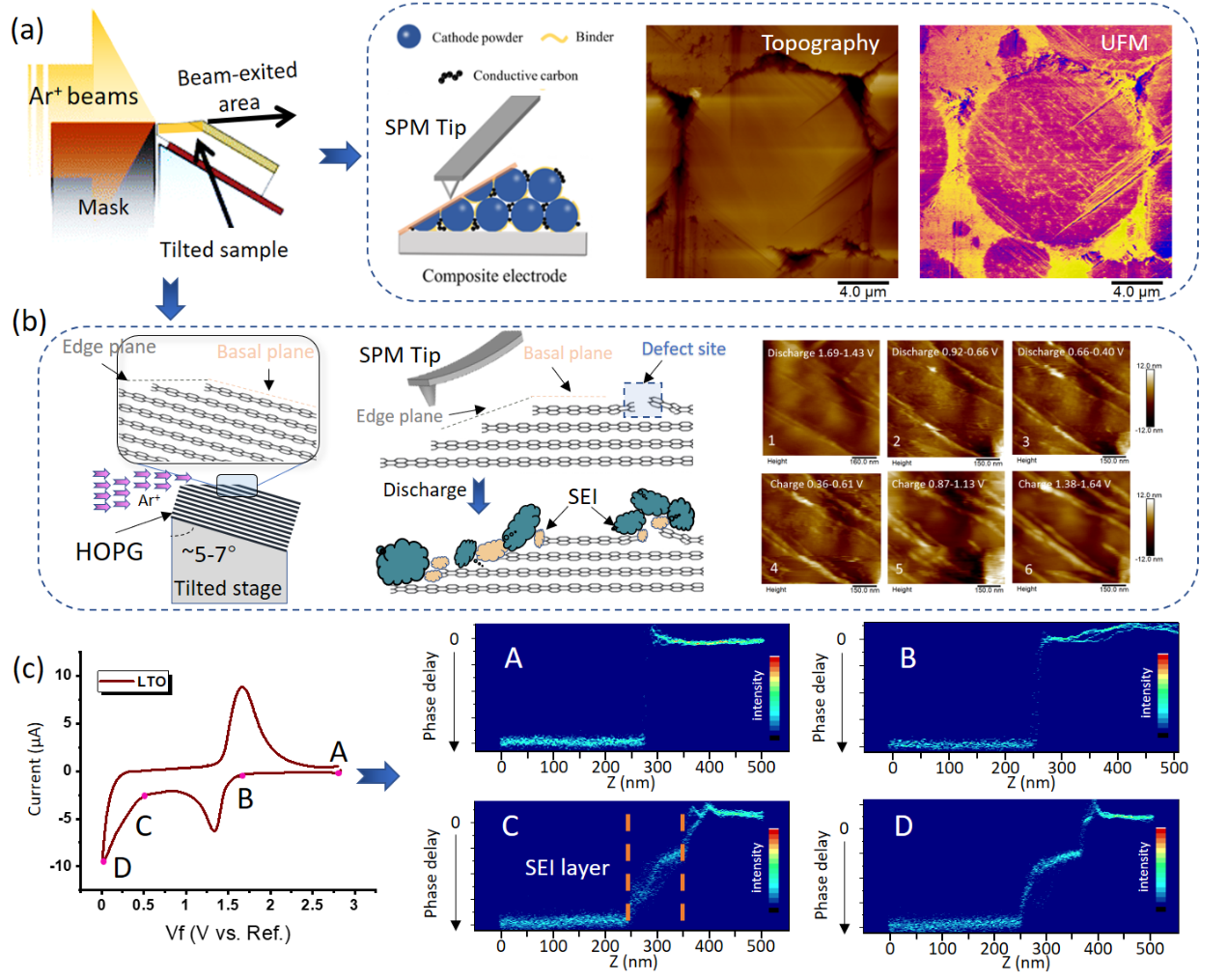Revealing the nanoscale fundamentals of batteries performance via x-sectional in-situ/operando Electrochemical SPM
- Abstract number
- 335
- Presentation Form
- Submitted Talk
- DOI
- 10.22443/rms.mmc2021.335
- Corresponding Email
- [email protected]
- Session
- Stream 4 (AFM): SPM Techniques on Energy Materials and Processes
- Authors
- Dr Yue Chen (2, 3), Dr Mangayarkarasi Nagarathinam (1), Dr Sara Rodrigues Costa (1, 3), Dr Nuria Tapia-Ruiz (1, 3), Prof. Oleg Kolosov (2, 3)
- Affiliations
-
1. Department of Chemistry, Lancaster University
2. Department of Physics, Lancaster University
3. The Faraday Institution
- Keywords
X-section in-situ/operando electrochemical SPM; EC-SPM; Beam-Exit cross-sectional Polishing; BEXP; lithium-ion battery; sodium-ion battery; ion intercalation; solid-state-interphase; SEI.
- Abstract text
Fig. 1 BEXP + operando UFM measurements of nanomechanical properties of SEI formation on (a) the NCA commercial battery cathode electrode and (b) HOPG model anode. Operando SFFM torsional vibration phase approaching spectra on deep-lithiated lithium titanite oxide (LTO) anode surface during the 1st cathodic scan.
Scanning Probe Microscopy (SPM) techniques have provided essential solutions for probing the nanophysical properties of battery materials, such as nano-electronic/ionic conductivity of battery materials [1] and Young's moduli of solid electrolyte interphase (SEI).[2] More significantly, in-situ/operando electrochemical (EC) SPM, operating simultaneously with the potentiometry/voltammetry in liquid electrochemical systems, has distinct advantages for observing the dynamic electrochemical processes (DEPs) happening on battery electrode/SEI-electrolyte (solid-liquid) interfaces,[3] especially the SEI formation and ion intercalation, which are critically important for lithium/sodium-ion batteries.
However, so far, the direct observations of the solid-liquid interfaces using in-situ/operando SPM are hindered by the rough topography and inhomogeneity on the battery solid electrode side. In this work we introduce the Beam Exit x-section nano-polishing (BEXP) to expand the studies of the commonly used model electrode, such as HOPG, with ultra-flat carbon atomic terraces and steps, to nano-sections of commercial composite electrodes (Fig.1a), and to artificial atomic scale steps in layered battery materials (Fig.1b). This enables the studies of ion-intercalations and SEI formations in the real-life materials for lithium/sodium ion batteries by a variety of in-situ/operando EC SPM modes. Furthermore, to overcome the limitation of traditional in-situ/operando EC SPM, that limit imaging to the immediate sample surface, we adapted the Ultrasonic force microscopy (UFM) [4] and Shear Force Modulation Microscopy (SFMM) modes to operation in the liquid electrolyte environment. With these ‘tip invasive’ SPM modes, the three-dimensional (3D) nano-rheology of the SEI layers was employed to provide detailed understanding of the in-depth distribution of the organic/inorganic species in SEI across the 2D area of the electrodes. The novel 3D nanorheology approach provides a 3D map of viscoelastic (complex phase and amplitude) response of the SIE to the local in-plane (shear) and out-of-plane modulation of the SPM tip.
By introducing the complementary sample preparation method and advanced SPM modes, several important DEPs, which are deeply ‘buried’ inside the operating lithium/sodium-ion battery, were observed in liquid electrolyte environment under battery operation conditions for the first time. To be specific, as shown in Fig. 1a, the dynamic CEI formations on the BEXP-polished commercial electrode surface was recorded by operando EC UFM mechanical mapping with high material sensitivity/contrast. The SEI formation on the graphite carbon atomic terraces and artificial steps were monitored and compared by operando SPM as shown in Fig. 1b, which confirmed that the SEIs formation are ‘defect-related’ at non-intercalation voltage range, while the SEIs formed on the edge sites are mainly ‘intercalation-related’ within the intercalation voltage range. Moreover, SSFM were used to study the 3D nanorheology of SEI layers formed on deep-lithiated/sodiated LTO/NTO anode surface. As shown in the torsional phase-Z approach-retract spectra in Figs. 1c, a significant phase shift can be found on the spectra C with clear transition from the viscoelastic response of the outer SEI layers to the solid-like response closer to the electrode surface. Furthermore, the 3D mechanical properties and exact geometry of the SEI layers can be reconstructed by the deconvolution of shear (torsional) amplitude and out-of-plane (vertical) deformation signals. An expansion to the lithium-ions intercalation induced cathode insulator-to-metal transition [5, 6] and the anode volume expansion/contraction [7] will also be discussed in this presentation.
In each characterization example, special attention will be paid to correlate the nanoscale SPM characterization results with the macroscopic battery performance, demonstrating the significant advantages of these in-situ/operando EC SPM approaches on the studies of energy materials and micro/nano-scale processes.
- References
1. Balke, N., et al., Nanoscale mapping of ion diffusion in a lithium-ion battery cathode. Nat Nanotechnol, 2010. 5(10): p. 749-54.
2. Weadock, N., et al., Determination of mechanical properties of the SEI in sodium ion batteries via colloidal probe microscopy. Nano Energy, 2013. 2(5): p. 713-719.
3. Pan, H., et al., Complementary sample preparation strategies (PVD/BEXP) combining with multifunctional SPM for the characterizations of battery interfacial properties. MethodsX, 2021. 8: p. 101250.
4. Robinson, B.J. and O.V. Kolosov, Probing nanoscale graphene-liquid interfacial interactions via Ultrasonic Force Spectroscopy. Nanoscale, 2014.
5. Chen, Y., et al., Insight into the intrinsic mechanism of improving electrochemical performance via constructing the preferred crystal orientation in lithium cobalt dioxide. Chemical Engineering Journal, 2020. 399.
6. Chen, Y., et al., In Situ Observation of the Insulator-To-Metal Transition and Nonequilibrium Phase Transition for Li1–xCoO2 Films with Preferred (003) Orientation Nanorods. ACS Applied Materials & Interfaces, 2019. 11(36): p. 33043-33053.
7. Chen, Y., et al., Suppressing volume change and in situ electrochemical atomic force microscopy observation during the lithiation/delithiation process for CuO nanorod array electrodes. Journal of Solid State Electrochemistry, 2018. 23(2): p. 367-377.

